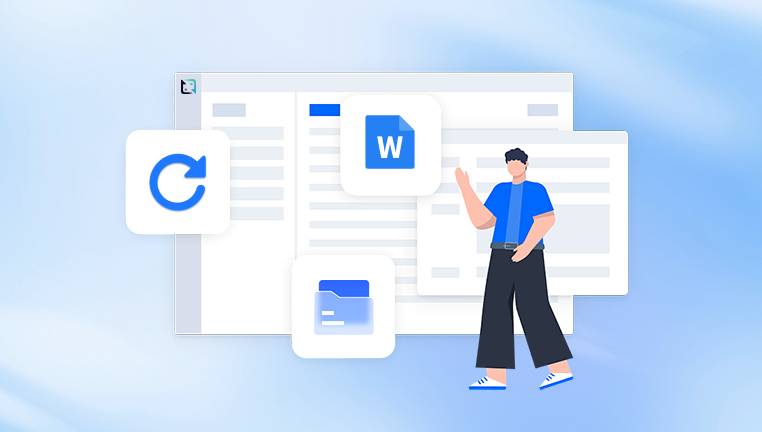Accidentally deleting a Word document can be an incredibly stressful experience, especially if it contains important work, research, or personal information. Fortunately, there are several methods available to help recover deleted Word documents, ranging from simple file recovery techniques to advanced third-party software.
Section 1: How Deletion Works
Before diving into recovery methods, it’s important to understand what happens when you delete a file:
Temporary Deletion: Files moved to the Recycle Bin (Windows) or Trash (Mac) can be easily restored.
Permanent Deletion: Files deleted using Shift + Delete (Windows) or emptied from Trash bypass recovery through traditional means.
Autosave & Versions: Microsoft Word often autosaves and creates temporary versions of documents, which can be leveraged for recovery.

Section 2: Check the Recycle Bin or Trash
The first and easiest place to look is the Recycle Bin (Windows) or Trash (Mac):
Open Recycle Bin/Trash.
Search for your document by name or file type (e.g., .docx).
Right-click and choose "Restore" to send the file back to its original location.
If you find the file here, recovery is immediate and simple.
Section 3: Use Word's Built-in Recovery Features
Microsoft Word includes several recovery features:
A. Recover Unsaved Documents (Windows)
Open Word.
Go to File > Info > Manage Document > Recover Unsaved Documents.
Browse the list and select your document.
Click Open, then Save As to a secure location.
B. AutoRecover (Windows & Mac)
AutoRecover is a background feature that saves your work periodically:
Files are typically stored in:
Windows: C:\Users\YourName\AppData\Roaming\Microsoft\Word\
Mac: /Users/YourName/Library/Containers/com.microsoft.Word/Data/Library/Preferences/AutoRecovery/
Navigate to the AutoRecover folder.
Look for recently modified .asd or .wbk files.
Open in Word and save as a new document.
C. Document Recovery Pane
If Word crashes, it often displays a recovery pane upon reopening. Select the appropriate file and save it immediately.
Section 4: Search for Temporary Files
Temporary files may help recover your deleted document:
A. Windows
Open File Explorer.
Search using wildcard: *.tmp or ~*.docx.
Look for files modified around the time of deletion.
B. Mac
Open Finder.
Use Spotlight or search bar to find recent documents or temp files.
Once found, rename the file with a .docx extension and try opening it in Word.
Section 5: Check OneDrive or Cloud Backup
If you're using Microsoft 365 or Word with OneDrive enabled:
Log in to your OneDrive account.
Check the Recycle Bin in OneDrive.
Navigate to Documents and look for your file.
If available, restore it directly to your local drive.
Other cloud backup services like Dropbox, Google Drive, or iCloud may also have version history or trash folders.
Section 6: File History and Previous Versions (Windows)
If you have File History or System Restore enabled:
Right-click the folder where the document was saved.
Select Restore previous versions.
Choose a version from before the file was deleted.
Click Restore to recover the document.
This is helpful if the document was saved and deleted after some time.
Section 7: Time Machine (Mac)
Mac users can utilize Time Machine:
Connect your Time Machine backup drive.
Open the folder where the file was last saved.
Launch Time Machine from the menu bar.
Use the timeline to browse for earlier versions.
Select and click Restore.
Time Machine restores the file to its original location.
Section 8: Use Command Prompt or Terminal (Advanced)
A. Windows Command Prompt
Open Command Prompt as Administrator.
Use: chkdsk C: /f and attrib -h -r -s /s /d C:\*.* to check for hidden files.
Recover any located files manually.
B. macOS Terminal
Use Terminal with commands like ls -a and sudo to explore hidden folders.
This method is recommended for advanced users only.
Section 9: Data Recovery Software Options
Drecov Data Recovery is a versatile data recovery software designed to help users restore deleted, lost, or inaccessible files from a wide range of storage devices. This includes hard drives (HDDs and SSDs), USB flash drives, memory cards (SD, microSD), digital cameras, external drives, and even formatted or corrupted partitions. Whether you’re a casual user, IT technician, or business professional, Drecov Data Recovery aims to provide a powerful yet accessible way to recover important data without needing extensive technical skills.
Key Features
Intuitive Interface: Drecov Data Recovery is built with simplicity in mind. Its clean interface makes it easy for beginners to scan and recover lost files with minimal guidance.
Multiple Recovery Modes: It offers quick scan for recently deleted files and deep scan for more complex cases involving long-deleted, overwritten, or corrupted files.
File Type Support: The software can recover documents (DOCX, PDF, XLS), images (JPG, PNG, RAW), videos (MP4. AVI), emails, compressed archives (ZIP, RAR), and more.
Preview Before Recovery: Users can preview recoverable files before restoring them, helping identify what’s important and avoid restoring unnecessary data.
Cross-Device Compatibility: Supports a variety of storage devices, including Windows and Mac file systems, USBs, SD cards, external hard drives, and internal drives.
Safe and Read-Only Scanning: Drecov Data Recovery operates in a read-only mode during scans, ensuring that existing data is not overwritten or damaged further during the process.
How It Works
Download and Install: Install Drecov Data Recovery from the official website. The lightweight program installs quickly on most modern Windows or macOS systems.
Select a Location: Launch the app and choose the drive or device where your files were last located.
Scan the Device: Choose between a quick scan or deep scan. Quick scan recovers recently deleted files, while deep scan is useful for formatted drives or long-deleted files.
Preview and Recover: Once scanning is complete, browse through the recoverable files. Use filters to sort by file type, size, or modification date. Preview files before recovery, then select and restore them to a secure location.
Common Scenarios Where Drecov Data Recovery Helps
Accidental deletion of photos, documents, or folders
Formatting an SD card or USB drive without backup
Recovering data from a crashed or corrupted hard drive
Retrieving lost files after system or software failure
Recovery of files emptied from the Recycle Bin
Advantages Over Competitors
Drecov Data Recovery stands out due to its balance of power and usability. While many data recovery tools are either too technical or too limited in function, Panda provides deep recovery capabilities without overwhelming the user. Its scanning engine is efficient, and it offers competitive success rates in recovering permanently deleted or inaccessible files. Furthermore, its affordable pricing plans make it accessible to both individuals and small businesses.
Section 10: Consult a Professional Recovery Service
If the file is extremely important and recovery tools fail:
Seek help from professional data recovery services.
They can access hard drives using advanced hardware techniques.
Services may be expensive but effective for critical loss situations.
Choose a reputable service that ensures data confidentiality.
Section 11: Preventive Tips for the Future
To avoid accidental deletion:
Enable AutoSave in Word and use OneDrive or Google Drive.
Use File History/Time Machine for automatic backups.
Manually back up documents weekly to an external drive.
Save frequently when editing large or important documents.
Use versioning systems like Git if managing large projects.




